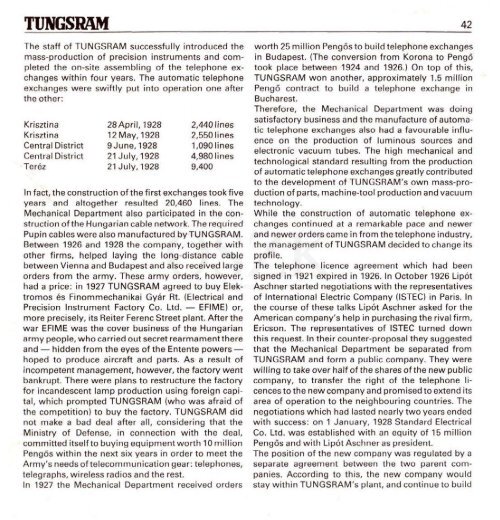THE HISTORY OF TUNGSRAM 1896-1945 - MEK
THE HISTORY OF TUNGSRAM 1896-1945 - MEK
THE HISTORY OF TUNGSRAM 1896-1945 - MEK
- No tags were found...
You also want an ePaper? Increase the reach of your titles
YUMPU automatically turns print PDFs into web optimized ePapers that Google loves.
<strong>TUNGSRAM</strong>*..V42The staff of <strong>TUNGSRAM</strong> successfully introduced themass-production of precision instruments and completedthe on-site assembling of the telephone exchangeswithin four years. The automatic telephoneexchanges were swiftly put into operation one afterthe other:KrisztinaKrisztinaCentral DistrictCentral District"^Terez28 April, 192812 May, 19289 June, 192821 July, 192821 July, 19282,440 lines2,550 lines1,090 lines4,980 lines9,400In fact, the construction of the first exchanges took fiveyears and altogether resulted 20,460 lines. TheMechanical Department also participated in the constructionof the Hungarian cable network. The requiredPupin cables were also manufactured by <strong>TUNGSRAM</strong>.Between 1926 and 1928 the company, together withother firms, helped laying the long-distance cablebetween Vienna and Budapest and also received largeorders from the army. These army orders, however,had a price: in 1927 <strong>TUNGSRAM</strong> agreed to buy Elektromoses Finommechanikai Gyar Rt. (Electrical andPrecision Instrument Factory Co. Ltd. — EFIME) or,more precisely, its Reiter Ferenc Street plant. After the. - war EFIME was the cover business of the Hungarianarmy people, who carried out secret rearmamentthereand — hidden from the eyes of the Entente powers —hoped to produce aircraft and parts. As a result ofincompetent management, however, the factory wentbankrupt. There were plans to restructure the factoryfor incandescent lamp production using foreign capital,which prompted <strong>TUNGSRAM</strong> (who was afraid ofthe competition) to buy the factory. <strong>TUNGSRAM</strong> didnot make a bad deal after all, considering that theMinistry of Defense, in connection with the deal,committed itself to buying equipment worth 10 millionPengos within the next six years in order to meet theArmy's needs of telecommunication gear: telephones,telegraphs, wireless radios and the rest.In 1927 the Mechanical Department received ordersworth 25 million Pengos to build telephone exchangesin Budapest. (The conversion from Korona to Pengotook place between 1924 and 1926.) On top of this,<strong>TUNGSRAM</strong> won another, approximately 1.5 millionPengo contract to build a telephone exchange inBucharest. ' ,.' .Therefore, the Mechanical Department was doingsatisfactory business and the manufacture of automatictelephone exchanges also had a favourable influenceon the production of luminous sources andelectronic vacuum tubes. The high mechanical andtechnological standard resulting from the productionof automatic telephone exchanges greatly contributedto the development of <strong>TUNGSRAM</strong>'S own mass-productionof parts, machine-tool production and vacuumtechnology.While the construction of automatic telephone exchangescontinued at a remarkable pace and newerand newer orders came in from the telephone industry,the management of <strong>TUNGSRAM</strong> decided to change itsprofile.The telephone licence agreement which had beensigned in 1921 expired in 1926. In October 1926 LipotAschner started negotiations with the representativesof International Electric Company (ISTEC) in Paris. Inthe course of these talks Lipot Aschner asked for theAmerican company's help in purchasing the rival firm,Ericson. The representatives of ISTEC turned downthis request. In their counter-proposal they suggestedthat the Mechanical Department be separated from<strong>TUNGSRAM</strong> and form a public company. They werewilling to take over half of the shares of the new publiccompany, to transfer the right of the telephone licencesto the new company and promised to extend itsarea of operation to the neighbouring countries. Thenegotiations which had lasted nearly two years endedwith success: on 1 January, 1928 Standard ElectricalCo. Ltd. was established with an equity of 15 millionPengos and with Lipot Aschner as president.The position of the new company was regulated by aseparate agreement between the two parent companies.According to this, the new company wouldstay within <strong>TUNGSRAM</strong>'S plant, and continue to build








![Letöltés egy fájlban [4.3 MB - PDF]](https://img.yumpu.com/50159926/1/180x260/letaltacs-egy-fajlban-43-mb-pdf.jpg?quality=85)







